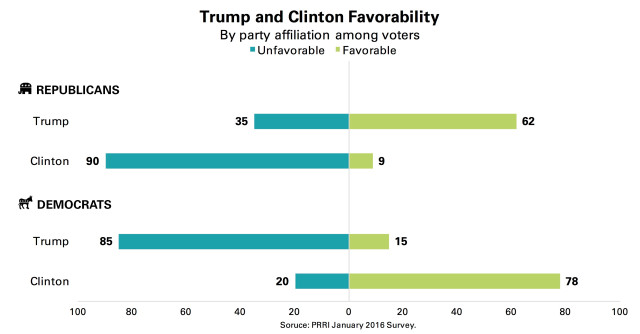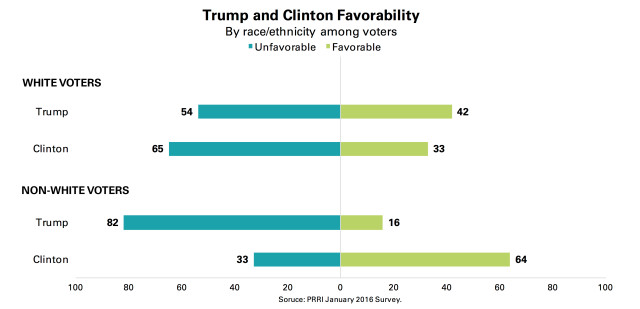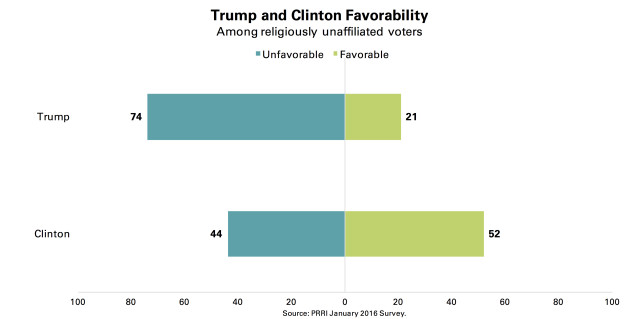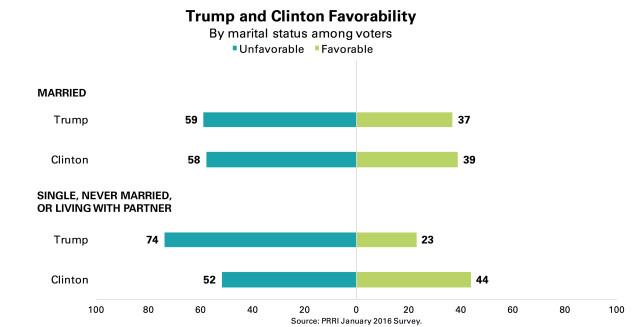In the last two decades, no winning presidential candidate has had favorability ratings below 51 percent, according to Gallup. If Hillary Clinton and Donald Trump emerge as their party’s nominees for president, as is becoming increasingly likely, Americans may end up electing a president who is viewed more unfavorably than favorably for the first time in the modern era. Recent reports from PRRI show that when it comes to general impressions of each candidate, however, Trump may be facing a far more serious likability deficit than Clinton.
While public views of Clinton are nothing to brag about—PRRI shows that just 42 percent of registered voters view her favorably—Trump’s favorability deficit is much worse: just 34 percent of American voters have a favorable opinion of him. Of course, public views of candidates are strongly colored by partisanship. Not surprisingly, then, PRRI finds that Republicans express much more positive views of Trump than Clinton, while Democrats are far more likely to view Clinton favorably than Trump.
However, what may be most troubling for Trump is that his net favorability score—the number of people who view him favorably minus the number of people who view him unfavorably—only registers 27 percent among Republican registered voters. Among Democratic voters, however, Clinton’s net favorability is a whopping 58 percent. Despite facing a tougher than expected challenge from Bernie Sanders, Democratic voters are still very fond of Hillary Clinton, and there is little reason to expect that such voters will not support her candidacy come November. Trump, however, still faces the prospect of having to win over voters in his own party.
There are also signs that Trump may struggle with several segments of an increasingly diverse and changing electorate. For instance, just 16 percent of non-white voters view Trump favorably, compared with 64 percent of non-white voters who view Clinton favorably. This statistic matters because the 2016 electorate is poised to be the most racially and ethnically diverse ever: Pew Research Center estimates that 31 percent of American voters will be non-white, which is up from 29 percent in 2012. Moreover, some evidence suggests that turnout among Latino voters in Democratic primaries is reaching record levels due in large part to a backlash to Trump’s surge in the G.O.P. primaries.
Another rapid demographic change in America concerns religion. As PRRI’s Dan Cox demonstrates, almost one in four Americans now consider themselves to be religiously unaffiliated. While it is true that the religiously unaffiliated have until now been less likely to turn out to vote than other religious adherents, Cox notes that they make up a disproportionate number of residents in important swing states such as Nevada, Colorado, New Hampshire, and Michigan. Just 21 percent of registered voters who are religious “nones” view Trump favorably, while 52 percent rate Clinton favorably.
Another potential challenge Donald Trump faces concerns marital status: the number of single Americans now outnumbers married Americans. This trend also presents a challenge to the eventual Republican nominee because married voters disproportionately support Republican candidates, while single voters lean Democrat. While Trump’s net favorability among married voters stands at a net negative of 22 percentage points, his net favorability is more than twice as negative among voters who have never married. In particular, single women who have never been married or are living with a partner seem to hold Trump in low regard, with 84 percent expressing a negative view of Trump. While these findings are suggestive, at best, journalist Rebecca Traister argues that single women in America are becoming a “potent political force” as they made up 23 percent of the electorate in 2012, so Trump’s poor showing among single women is not likely to help his campaign.
Of course, these findings about favorability come with lots of caveats. Macro-economic factors such as the unemployment rate still may matter more in helping to explain vote choice for president. Political scientists routinely point out that early polls rarely predict election outcomes given that most voters are not paying attention to the election yet. But Donald Trump and Hillary Clinton have near universal name recognition, a factor that could make such favorability ratings more predictive.
Perhaps the only good news for Trump in this scenario is that Hillary Clinton is not exactly cultivating warm and fuzzy feelings among most Americans. As the New York Times aptly noted last week, Trump and Clinton are “winning votes, but not hearts.” But Clinton’s net favorability in some vital demographics are poised to give her the edge come fall if she is the nominee, much to the consternation of the G.O.P.
Dr. Melissa Deckman is the Louis L. Goldstein Professor of Public Affairs and Chair of the Political Science Department at Washington College. Dr. Deckman serves as Chair of PRRI’s Board of Directors. Follow her on Twitter.



